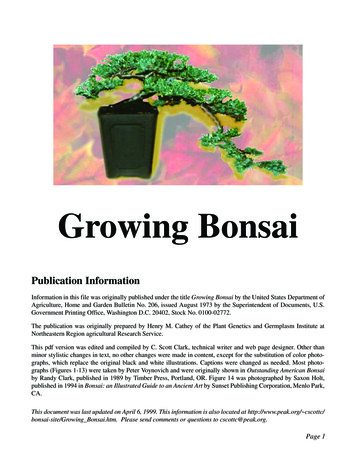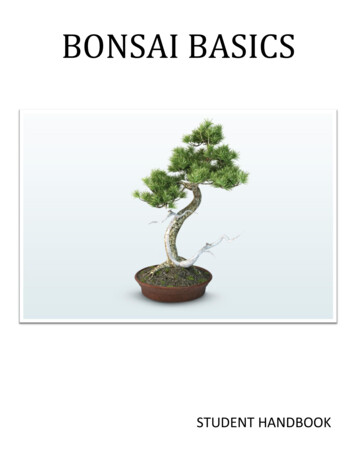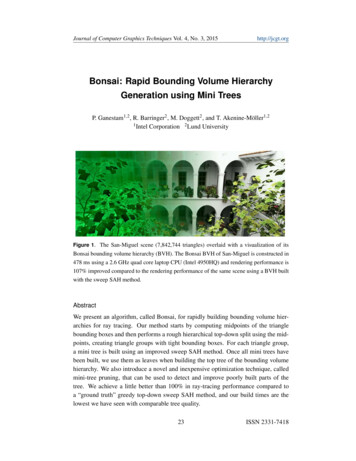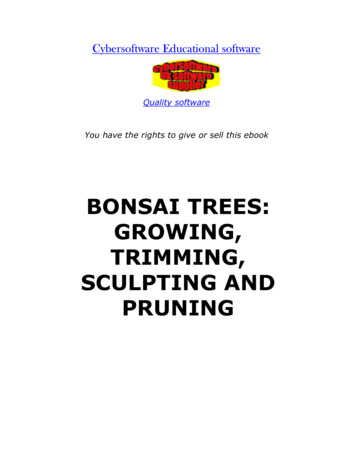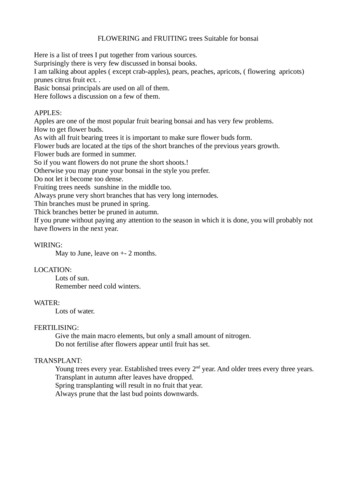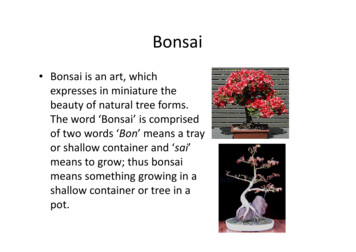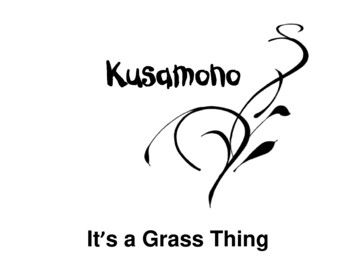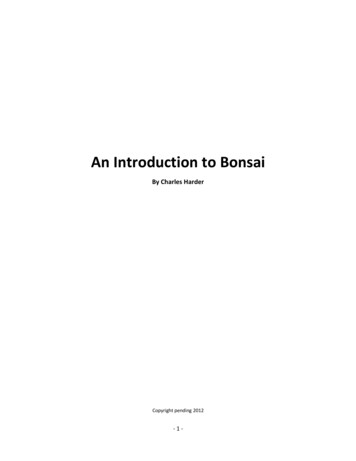
Transcription
An Introduction to BonsaiBy Charles HarderCopyright pending 2012-1-
Good types of plants and trees for beginning bonsai:Maple: Japanese or Trident (Acer Palmatum or Acer Buergerianum)Juniper: there are many species with common names like: Hollywood, Shimpaku, Green moundElm: (Ulmus Parvifolia)Crab Apple or even regular Apple: (Malus Sylvestrus or Malus Malus)Cotoneaster: (Cotoneaster Horizontalis)Hornbeam: (Carpinus Betulus)Flowering QuinceOrnamental PomegranateCedar: Blue Atlas or Deodar*Tam Juniper and Italian Cypress do not make good bonsai and they will frustrate and disappoint you.Some Basic Bonsai Terms:Bonsai: (Pronounced “Bone – Sigh”) this is actually a conjunction of two words: Bon (Pen) meaning basinor pot and: Sai, meaning to plant.Jin: this is a dead branch or stub of a branch – achieved by removing the bark and or tearing or carvingin such a way that it appears to have fallen off due to age or the elements.Shari: (Or Sharimiki) This is where the bark of the trunk has been removed, sometimes even the entiretop section of the tree – trees that have been struck by lightning, survived a fire or a branch has fallenoff and ripped a section of the tree away – also achieved be a selective removing of the bark.Dai: this is the platform or mat that your tree is displayed on.Nebari: this is basically the exposed roots in your pot – most mature trees have a base of roots, thateven if marginally visible, shows that the tree has a stable base – this is an important aspect to give theimpression that the tree has been growing a long time.Movement: This is where the art of bonsai comes in; the trunk needs to flow from side to side and alsofront to back (except in the case of a formal upright tree) and the branches need to give the impressionthat nature has molded them – remember to draw upon what nature has shown you and what feelsright to you.Front: Yes your tree will have a front – which will be the direction that faces the viewer – but rememberthat this is a 3 dimensional art and should be styled with that in mind. @% *#: When you are bending a wired branch and you hear it break.-2-
What is bonsai?Let’s start with the word; pronounced “bone – sigh” this literally means: plant in a pot. There isno such thing as bonsai seeds; what they are selling in those packages are just various tree and plantseeds. What we use for bonsai is; any woody plant with well proportioned leaves or needles. Quite a fewtrees, bushes and even herbs have the potential to be a bonsai. The primary intent is to create a treethat is a miniature version of what you would see in nature or to represent a much larger tree.To begin; let us examine the anatomy of a bonsai tree: starting with the roots, then the trunk,branches, foliage and finally the pot.Roots:Look at an older, well established tree; either the roots will spread out along the ground, beforefinally disappearing into the soil, or there will be a distinct flare near the base of the tree at ground level.Whether the roots bury into the ground or you see exposed roots, try to encourage a solid looking rootbase, this will provide the impression of a well established tree. If the roots of your bonsai are thin orunevenly spaced, one can provide the illusion of solidity, by placing larger stones, to give the impressionof growing up through rocks, or you can mound up the soil a bit to provide the illusion of root taper.Trunk:With a bonsai tree, you typically want a lot of “movement” in the trunk. In essence what thatmeans is that you want the trunk to move from side to side as well as front to back. If the trunk isstraight, then it needs to be straight throughout the tree. If there is a slight curve, then maintain thecurve and have the branches reflect the same. Always look for a trunk-line that has some interest. Theother feature that helps with the esthetics is that the trunk should start out at its base with a flare andthen gradually taper towards the apex or top of the tree. If your tree has an interesting bark fissured andcraggy, that helps with the impression of age.Avoid any trunk that has a bulge in the middle of the trunk or what is known as inverse taper – mosttypically found on grafted trees - it will take far to many years to try and correct this type of deformity.Branches:The first branch should start about one quarter to one third the way up the trunk, and thisshould also be your longest and thickest branch. Then gradually reduce the thickness and length of eachbranch as they go up the tree. The second branch should be on the opposite side of the tree. The thirdbranch should be directed toward the rear of the tree and then continue the pattern as you proceed upthe tree. If the trunk is angular or straight, then the branches should continue the pattern or style. If thetrunk is curved, then you want your branches to curve as well. The tree will end up looking odd, if youhave a straight trunk and angular or curvy branches.Foliage:Ideally the smaller leafed plants, will make more convincing bonsai, however, there are severaltypes of plants and trees that by regular leaf pruning and care, can reduce the leaf size. A lot of junipersand pines can naturally work well with the tree style that you choose. Bear in mind, the leaf size whendetermining the size of the tree that you grow or train. It will help with the impression, if the foliage is inproportion to the size of your tree.Pot:The pot should compliment your tree, not only in color, but also size and shape. A good rule ofthumb is; for the depth of your pot to be 2 time the diameter of the trunk and the width should be 1 to1-1/2 times the height. But remember, these are only suggestions and the bottom line is that the potcompliments the tree.-3-
Basic rules for bonsai (more like suggestions)Position branches on the outside of the trunk or branch bends.Avoid branches on the inside of bends.The purpose of wiring is to move a branch to a new position.If the position or shape is what you want, then thereis no need to add wire.When wiring; keep wraps evenly spaced, and snugbut not so tight that it “bites” into the wood, andnot so loose that it does not support the branch oror trunk.Bend HereNot HereAnchor wire, either into the soil or around another branch.Always offset tree position in pot (do not center tree)-4-
Try to create a visual triangle between tree and pot.For most styles, you will want the apex (top) of the treeand the trunk to be on the same centerline.Attempt to not have 2 or more branchesdirectly opposite each other (bar branch)Try not to allow branches to cross over each other.The first branch should be the thickest and longest branch. The second branch should be slightly shorter,and on the opposite side of the tree. The third branch toward the rear of tree and so forth up the trunk.Generally the apex (top) of the tree should lean toward the viewer.All of the above being said, these are all merely suggestions and there are no hard and fast rules forbonsai. If you achieve the look you want and are happy with the results, then how you have styled yourtree is correct.Bonsai is an art form, and you are the artist, if it is pleasing to you and you like the way it looks, thenit is perfect!-5-
The bonsai year:Winter:In early winter, there is still a little time for last minute wiring before the wood hardens off. Butlater this season, it becomes a time for reflection; a time to sharpen and clean and oil your tools, a timeto clean out empty pots and locate new ones, a time to review your books and magazines, or a goodtime to sketch out ideas for some of your trees in training and play with the concept of restyling anexisting tree by sketching it into a different style. This is not a time to fertilize, be patient and eagerlywait until the first appearance of leaf buds before resuming any feeding.Okay, so it’s raining, but is it enough for your tree? It is always better to check the moisture content ofyour trees, as winter winds can dry out your tree almost as fast as summer heat.Cover or bring in delicate trees near the house or into the garage on nights you expect a hard frost.Spring:This is where the real fun begins; this is the time of year for vigorous growth, potting and styling.Early spring is a perfect time to begin any air layering you may want to do. This time of year you will bebusy, styling trees, checking wire on your branches to make sure that the rapid growth does not swellbeyond the wire – this will cause scarring on the trunk and branches if not removed in time that will takemany years to heal avoiding the dreaded spiral scaring.Water regularly and fertilize frequently – if you are using a common liquid style fertilizer use it at halfstrength from the listed instructions, but a bit more often.Summer:Keep an eye on your plants health and if needed, spray them to keep them pest free. Rotateeach plant every week or two to maintain an even growth and fresh air, plus this allows you to check onthe health and shape from all sides, especially if your tree is near a wall or fence.Do not let your plants grow out of control, especially the faster growing trees like maples, junipers andelms. Keep new growth trimmed or pinched so you do not lose the shape you’ve spent all your timeworking on. Thin out any compact or dense growth to allow air and light to reach the interior of yourtree.Be aware of which trees need shade, partial sun or prefer full sun, but definitely pay attention to themoisture level in the soil.Fall:Here again is a second growing season, perhaps not as rapid or vigorous as in the spring time,but your trees have another opportunity to get out of control, you will begin to learn which trees youwill need to spend more time with. Begin feeding with a high phosphate fertilizer for your floweringtrees to build up reserves and buds for next spring. This is also a good fertilizer for your pines andjunipers.-6-
Wire:The wire we use will either be aluminum wire with a copper coating or copper . Aluminum wireis easier to bend and is a little less expensive, but it will generally take a larger gauge wire to bend abranch than you would with the copper wire. If you are using copper wire, then I suggest that either youbuy it annealed through a specialist store or you can go to your local electronics supply and purchasegrounding wire and anneal it yourself. To anneal the wire place it into your fire place or into yourbarbeque after you are done cooking and allow the wire to get orange hot, then remove and allow tonaturally cool down (do not quench the wire with water or a blast of cold air otherwise it will harden thewire as opposed to making it soft and easy to work with.Sources for bonsai material:The best places to look for plant materials are: local garden centers and nurseries. Look for thetree, plant or bush that no one else wants, due to it having a misshaped branch or overly long trunk, oreven a section that has died out. There are also a number of bonsai nurseries where the material hasalready been started and typically the tree has already had some root pruning and even general branchplacement, however, this material tends to be more costly than basic garden material. For pots, thereare several locations that sell imported pots or you can purchase them online. Tools and wire also canbe found locally or online.Books:I find a lot of bonsai books at thrift shops and discount used book stores, as well as the newbooks through online and local bookstores.Some thoughts on watering: First: and the most obvious reason it provides water for your tree.Second; the water that flows through the soil carries nutrients to and through the roots yourtree needs. Third: and least obvious, the flow of water washes the spent gasses and mineral salts thatotherwise might build up in the soil which would harm the health of your tree and pulls in freshair.An old saying is to water three times:Once for the soilOnce for the pot andOnce for the treeBe aware of the water retention in each tree’s soil; slight differences in the soil materials fromeach plant as well as the pot size and depth, location in your yard and the type of tree makes the; “onemethod fits all” style of watering difficult. Learn to customize your watering habits to conform to yourindividual trees needs.By passing the water over your tree at least three times with your sprayer, you allow the waterto soak into the soil and leave some extra water for giving the organic material time to hydrate and soakup the moisture fir the tree to absorb later. Remember that all parts of the plant absorb water to somedegree, so do not water just the soil, around 30% of the moisture intake for a plant doesn’t involve theroot system at all. By washing off the foliage it helps the plant absorb moisture and keeps the dust andpollutants off of the plants leaves.-7-
Soil:The soil you chose for your tree will affect how the roots grow, and also impacts feeding andwater absorption; it is where the other half of your tree lives, so this is your second biggestconsideration in maintaining the health of your tree. The soil requirements of each individual tree willvary, but a good rule of thumb if you are just starting out is: 30% inorganic and 70% organic fordeciduous trees and 70%inorganic and 30% organic for conifers and evergreen plants.I joke that if you have a room of 10 bonsai enthusiasts, you will have 10 different recipes for the perfectbonsai soil.If you are very new to the hobby and are not sure, then I would recommend you use a standardcactus potting mix for your bonsai soil, until you familiarize yourself with the soil needs of your varioustrees. The most important feature is that the soil be well draining so as not to smother the roots orallow mineral salts to build up in your pot.One can always buy pre-made bonsai potting soil which has better draining properties than agarden center regular potting mix and generally does not have mixed in fertilizer. You can find this soil i
The bonsai year: Winter: In early winter, there is still a little time for last minute wiring before the wood hardens off. But later this season, it becomes a time for reflection; a time to sharpen and clean and oil your tools, a time to clean out empty pots and locate new ones, a time to review your books and magazines, or a good
